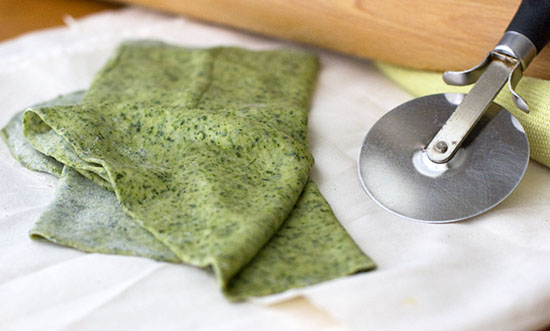Daring Bakers Challenge : Lasagne

The March 2009 challenge is hosted by Mary of Beans and Caviar, Melinda of Melbourne Larder and Enza of Io Da Grande. They have chosen Lasagne of Emilia-Romagna from The Splendid Table by Lynne Rossetto Kasper as the challenge.
I had my first taste of lasagne when I was about ten. I still remember it, not for it’s culinary excellence, but because I was obsessed with Garfield at the time, and lasagne was Garfield’s favourite food. I also recall the moment clearly because I was in awe at my friend’s glamorous mother who, from her glamorous kitchen, pulled out this glass casserole dish of mysterious lasagne.
I have eaten a few more lasagnes since then. Mom would make us her deliciously inauthentic versions on occasion – my favourite bit was always the crispy golden crust on top. Somehow though, lasagne never equated to me as something I craved on a regular basis. In fact, I can’t even remember the last time I ate, let alone baked, a lasagne.
Until, that is, this month’s DB challenge. The choice of lasagne took me by surprise, but I welcomed it with open, floury arms, relishing the idea of making a lasagne entirely from scratch. Pasta and all! Foregoing the purchase of a pasta machine, I decided to hand roll my pasta, which I knew would be a challenge unto itself, on account of my weedy arms. So I strugged, and broke into a sweat, and struggled some more. All this, whilst trying to channel my two very un-Italian/extremely-Chinese grandmothers; one of whom made noodles by hand on a daily basis for her large family, and the other still has the patience to make thousands of miniature deep fried spring rolls, each one thinner than a pencil. The end result, after much sponging of the brow and discrete swearing under the breath, was well worth the effort, with B giving the dish a big thumbs up.
Of the three recipes provided for this challenge, I completed two : the spinach pasta and the bechamel sauce. Instead of the ragu, I went vegetarian and opted to make a basic tomato sauce. Since the recipes are quite long, I’m only including the spinach pasta recipe in this post, which I would unhesitatingly make again.

(Pictured : Spinach pasta sheet, rolling pin, cutter and extra cloth for sponging brow)
Spinach Egg Pasta (Pasta Verde) :
(Makes enough for 6 to 8 first course servings or 4 to 6 main course servings, equivalent to 450g dried boxed pasta; based on the recipe for the lasagne of Emilia-Romagna)
2 jumbo eggs (60g or more)
300g fresh spinach, rinsed dry, and finely chopped; or 170g frozen chopped spinach, defrosted and squeezed dry
400g all purpose unbleached (plain) flour [I used Italian OO flour]
Mixing the dough:
Mound the flour in the center of your work surface and make a well in the middle. Add the eggs and spinach. Use a wooden spoon to beat together the eggs and spinach. Then gradually start incorporating shallow scrapings of flour from the sides of the well into the liquid. As you work more and more flour into the liquid, the well’s sides may collapse. Use a pastry scraper to keep the liquids from running off and to incorporate the last bits of flour into the dough. Don’t worry if it looks like a hopelessly rough and messy lump.
Kneading:
With the aid of the scraper to scoop up unruly pieces, start kneading the dough. Once it becomes a cohesive mass, use the scraper to remove any bits of hard flour on the work surface – these will make the dough lumpy. Knead the dough for about 3 minutes. Its consistency should be elastic and a little sticky. If it is too sticky to move easily, knead in a few more tablespoons of flour. Continue kneading about 10 minutes, or until the dough has become satiny, smooth, and very elastic. It will feel alive under your hands. Do not shortcut this step. Wrap the dough in plastic wrap, and let it relax at room temperature 30 minutes to 3 hours.
Stretching and Thinning:
With a regular-length rolling pin, roll out a quarter of the dough at a time and keep the rest of the dough wrapped. Lightly sprinkle a large work surface with flour. The idea is to stretch the dough rather than press down and push it. Shape it into a ball and begin rolling out to form a circle, frequently turning the disc of dough a quarter turn. As it thins outs, start rolling the disc back on the pin a quarter of the way toward the center and stretching it gently sideways by running the palms of your hands over the rolled-up dough from the center of the pin outward. Unroll, turn the disc a quarter turn, and repeat. Do twice more.
Stretch and even out the center of the disc by rolling the dough a quarter of the way back on the pin. Then gently push the rolling pin away from you with one hand while holding the sheet in place on the work surface with the other hand. Repeat three more times, turning the dough a quarter turn each time.
Repeat the two processes as the disc becomes larger and thinner. The goal is a sheet of even thickness. For lasagne, the sheet should be so thin that you can clearly see your hand through it and see colours. Cut into rectangles about 10 x 20 cm. Note: Enza says that transparency is a crucial element of lasagne pasta and the dough should be rolled as thinly as possible. She says this is why her housekeeper has such strong arms!
Dry the pasta at room temperature and store in a sealed container or bag.
Tags: Daring Bakers, lasagne

